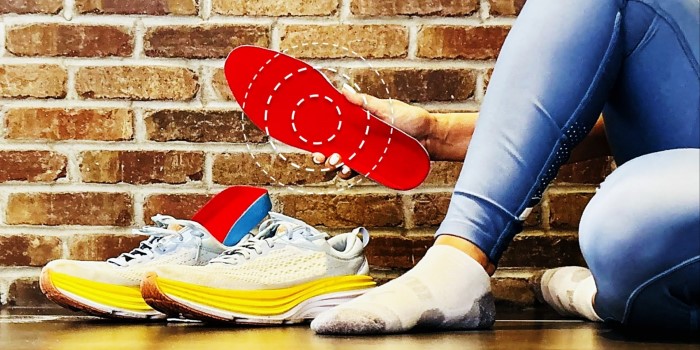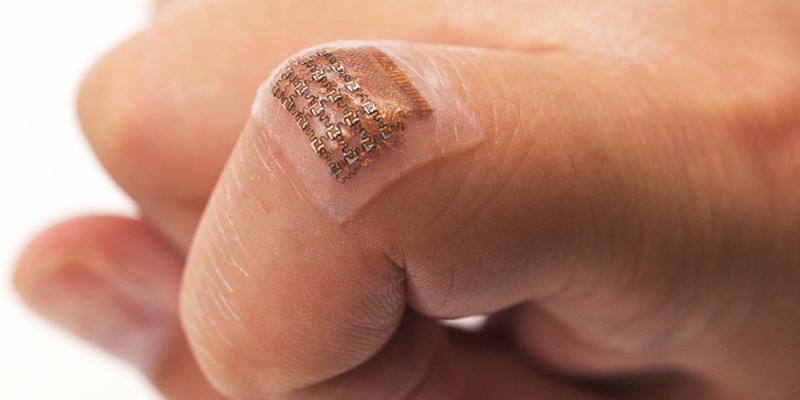‘Wearables’ doesn’t just mean Fitbits and smart watches anymore. The term encompasses a whole bunch of cutting-edge technologies that are making real-time medical monitoring and treatment more effective and comfortable than ever. Integrating AI, telemedicine, and sensor-based technologies, some developments are more sci-fi and surprising than others.
Wearables are not just watches anymore
Innovation in sensor technology is transforming the world of wearable IVDs and medical devices. Strides in miniaturisation, IoT and AI are making real-time tracking, diagnosis and treatment possible in ways that were unimaginable just a few years ago.
'Smart clothes' and headsets, single-use patches and other appendages are among a host of innovations that are being made possible by smaller, thinner and more capable MEMS and MOEMS.
What can MEMS do?
MEMS are the sensors that measure physical properties or chemical changes within their surrounding environment, such as temperature, acceleration and pressure. MOEMS are Micro-Opto-Electro-Mechanical Systems, that use optics for imaging, measurement and actuation.
Common types of sensors include accelerometers, pressure gauges (which measure force), flow meters (which measure fluid flow), and gyroscopes (which measure angular velocity).
This technology is getting smaller than ever. MEMS can range from several mm to an impossibly small size: less than 1 micrometre or 1000 of a millimetre. At this size, it is not even visible to the human eye.
At the same time, new materials, coatings, and finishes ensure they are becoming safer and more comfortable for use in intimate, bodily settings. What’s more, their extraordinary sensitivity and capacity for data capture and actuation continue to grow, making hyper-personalised healthcare possible, even outside practice or clinic walls.
Sensor development transforms the medical wearables market
Sensors used to measure and track specific bodily functions like muscle and brain activity include Electromyographic (EMG) and Electroencephalographic (EEG) based MEMs.
Meanwhile, cMUTs (Capacitive micromachined ultrasonic transducers) are paving the way for wearables that can transmit images of organs and even the inside of veins and blood vessels.
Next-generation ultrasound transducers developed by researchers in Canada that can be integrated into adhesive patches the size of postage stamps, making remote ultrasound procedures, among other things, possible. Their potential for ‘mass-fabrication and versatile integration’ will make preventive, real-time medical monitoring for otherwise invisible conditions easier and cheaper than ever before.
The rise of remote healthcare
Telemedicine has revolutionised healthcare delivery by democratising healthcare worldwide. It removes geographical barriers and enables remote consultation, diagnosis, and treatment.
Integrating telemedicine with wearable devices and cloud-based platforms supports real-time diagnostics, continuous monitoring, and immediate feedback, ensuring patients receive timely interventions without visiting a clinic. And as sensor technologies evolve, telemedicine will become increasingly personalised and predictive.
Thirteen companies pioneering wearable medical devices
Here are 13 of the most innovative wearable medical device companies transforming healthcare that we’ve spotted out in the market and at trade shows like MEDICA and COMPAMED:
1. Philips
Long recognised as a healthcare company, Philips offers an extensive range of healthcare solutions, ranging from MRI scanners to electric toothbrushes. Its wearable biosensors are designed for continuous patient monitoring and tracking vital signs such as heart and respiratory rate, facilitating early detection of patient deterioration for timely interventions.
2. Siemens Healthineers
The healthcare arm of Siemens and parent company to several MedTech companies, Healthineers has developed a portfolio of AI solutions focused on integrating wearable technologies with diagnostic imaging and patient monitoring systems. Their innovations provide continuous health data, support clinical decision-making, and improve patient outcomes.
3. Biotricity
Pairing award-winning health technology with best-in-class software, Biotricity focuses on medical-grade wearables for cardiac monitoring. Spanning diagnosis, disease, and lifestyle management, their devices, such as Bioflux, provide real-time ECG monitoring used for diagnosing and managing cardiac conditions, bridging the gap between patients and healthcare providers.

4. Garmin Health
A long-standing industry leader in consumer-grade wearables, Garmin Health specialises in wearables that monitor various health metrics, including heart rate, sleep quality and patterns, cardiological and neurological wellbeing, and activity levels. Their devices are increasingly used in clinical research and corporate wellness programmes to promote health and wellness.
5. GE HealthCare
With expertise in medical imaging, diagnostics, patient monitoring systems, drug discovery, and performance improvement solutions, GE HealthCare offers wearable devices that monitor vital signs and other health metrics. These wearables are designed to seamlessly integrate with hospital systems, providing real-time data to healthcare providers and enhancing patient care.
6. Inviza
Inviza has created innovative tracking insoles designed for remote patient monitoring. These insoles seamlessly integrate into footwear and establish automatic connections with smartphones. Individuals can access real-time fitness and location biometric analytics by wearing these insoles while walking, skipping, or running.

7. H-Cube
H-Cube, an Italian startup, has developed an advanced product called H-Tee, specifically designed for athletes. This smart t-shirt incorporates cutting-edge technology, including contactless electrodes and batteries, to extract various vital signs such as cardiac variability, heart rate, body temperature, blood pressure, and respiratory rate.
8. ABIORO
ABIORO, a Brazilian startup, is focused on revolutionising cardiac event monitoring with its Abioro RX Patch. This wearable patch is a practical alternative to traditional holter monitors, delivering an ergonomic and comfortable experience. By leveraging bio-sensing and deep learning technologies, the Abioro RX Patch accurately diagnoses cardiac arrhythmia, providing doctors with reliable data for remote patient monitoring.
9. EMOTIV
EMOTIV is a company developing EEG (Electroencephalogram) tech for business and medical use. Using sensors integrated into headsets, the technology gathers information about an individual's brain activity for insight into emotional states and cognitive responses triggered by external stimuli. Headsets are sold to academic researchers and even marketers who want insight into consumer reactions to products and adverts:
EMOTIV’s portable EEG headsets measure brainwaves with millisecond accuracy — providing real insights into how someone feels about your products or media.
The technology is currently being explored for its potential to help those with neurodegenerative diseases control devices and communicate through apps by the power of their thoughts alone.
10. Imago Rehab
Imago Rehab has developed a soft robotic glove to support medical rehabilitation in stroke patients. It incorporates sensors to help patients exercise weak limbs properly, with MEMs being used to monitor and support delicate muscle responses:
To make the glove comfortable and natural feeling to wearers, the actuators powering the movements of the glove were made smaller and modified over several iterations of design to distribute forces more evenly over the wearer’s fingers and thumb.
IoT ensures data about improvements in muscle performance can be relayed in real-time to physios, who can then make remote adjustments to exercise regimes via the gloves.
11. Medtronic
Medtronic have developed their MiniMed™ 780G System, as the next phase in their artificial pancreas development for Type 1 Diabetics. The hybrid closed loop (HCL) system uses biosensor patches to keep track of glucose levels and actuates insulin delivery as required. The design incorporates meal detection technology that automatically adjusts and corrects sugar levels every 5 minutes.
12. DFree
DFree is developing support products for urinary incontinence. It uses a non-invasive sensor attached to patients’ bodies to support incontinence management around the clock. The product uses ultrasound technology to detect when the bladder is full and notify patients, via an app, when they need to urinate.
13. University of California
A team at the University of California in San Diego, has pioneered a single, wireless ultrasound adhesive patch that can monitor blood pressure, heart health, and lung capacity in real-time:
The credit-card-size ultrasound patch can monitor signals from tissues as deep as 16 centimetres under the skin. It can continuously measure blood pressure, heart output, respiratory health, and other physiological signals for up to 12 hours on a single charge.

The challenge of developing wearables for the healthcare market
Researchers and entrepreneurs are exploring new possibilities for wearable medical devices. But commercial, regulatory and practical pressures can easily stop novel ideas from being realised.
Dealing with the complexities of building devices that are comfortable, efficacious, and viable is one thing. Meeting all the FDA requirements for testing and proving the safety of ‘novel’ medical products is another. Moving from ideation to development can take more than 7 years, clinical trials can take between 1 and 3 years, and PMA approval from the FDA for bleeding-edge devices can take more than 3 years to achieve.
Balancing commercial potential and regulatory approval can be hard
Don’t forget Apple’s iWatch was released with huge fanfare in 2015, hailed for its potential to transform preventive medicine, but was not then approved as ‘a medical device’ by the FDA. The leap from a fitness or wellbeing device to a medical-grade diagnostic tool is huge.
Companies wanting to bring their wearable innovation to a medical market must ensure their devices are built to the highest possible safety standards while remaining commercially viable.
To achieve this, designers and developers must collaborate with manufacturers with the experience and facilities to deliver at scale in the medical device sector. They will need access to complex supply chains, specialist components and highly skilled labour. They’ll need to ensure the microscopic MEMs and MOEMs they require are produced to exacting FDA standards but can still be manufactured at the required scale. Many will need to value engineer their approach and apply DFX (Design for Excellence) techniques to achieve the dream of wearable medical devices for all.
Working with the right manufacturing partner is the first step. For a partnership that can meet your wearable medical device manufacturing needs, contact ESCATEC.
Editor's note: This blog was originally published in October 2023 and has been updated in November 2024 for relevance and accuracy.



